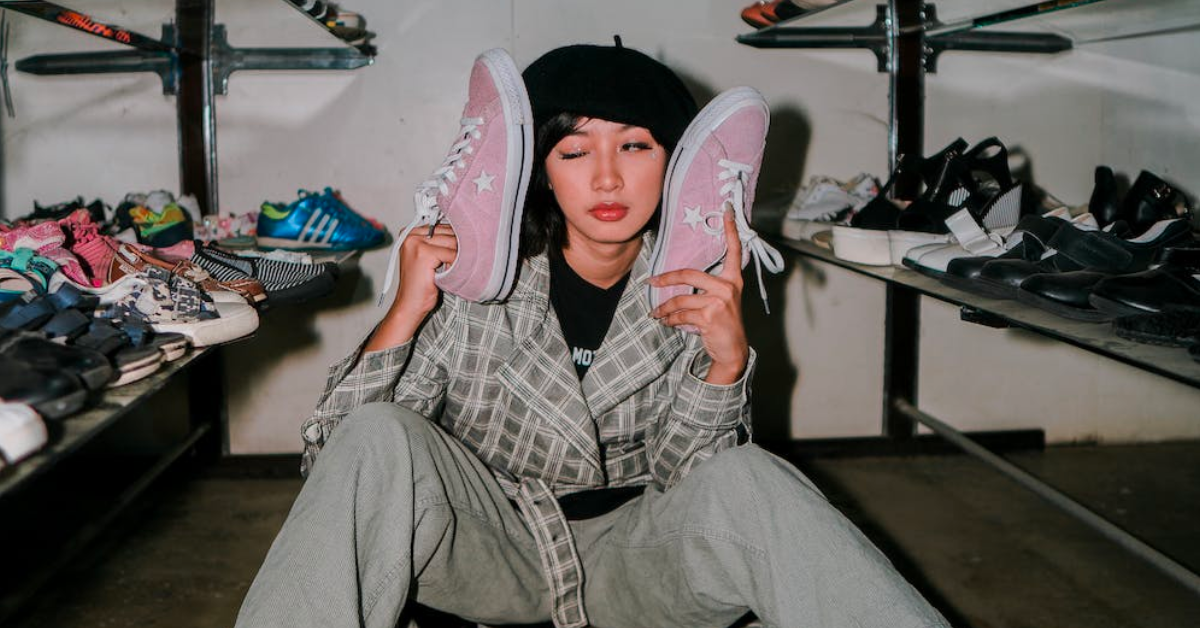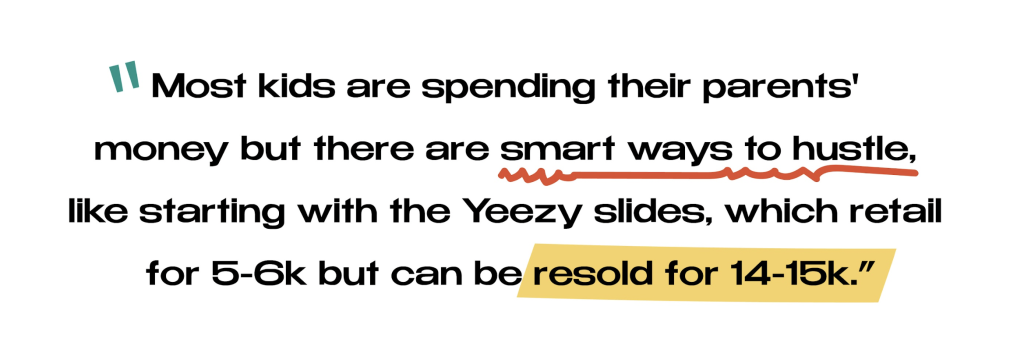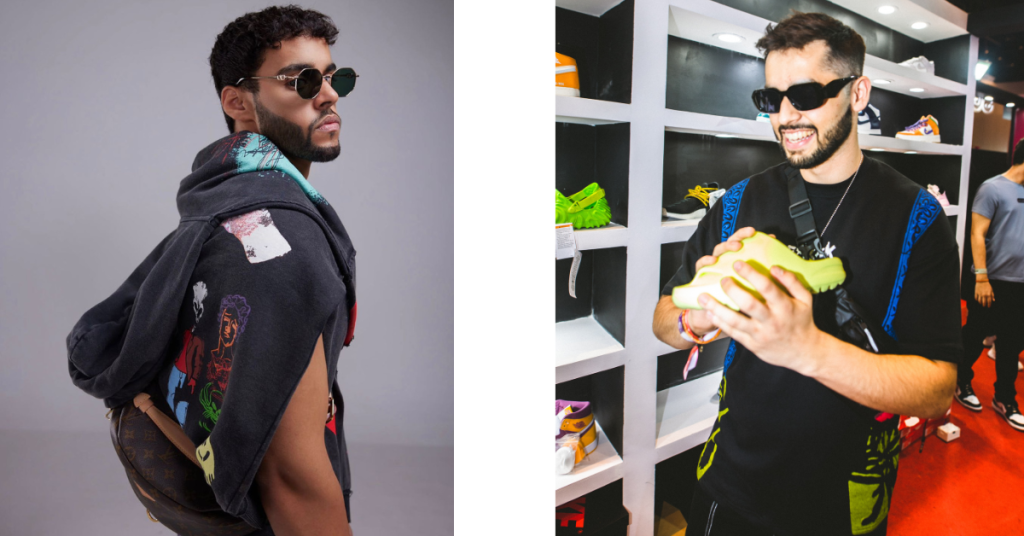
As an outsider to the sneakerverse, I’m perplexed. Don’t get me wrong, I recognise the utility and the appeal of shoes, but spending a fortune on each pair? Absurd. Then again, I’m a millennial who uses words like ‘Sneakerverse’, and initially thought VegNonVeg was a vegan restaurant with a questionable name.
Turns out, it’s a bright green building that’s hard to miss, and probably a shame to miss if you’re a sneaker-head. The multi-brand sneaker store owned by Anand Ahuja and Abhineet Singh in Bandra, Mumbai is so chic, it feels like a new age art gallery. People were admiring the shoes like they were the Mona Lisa.
I couldn’t help but wonder, “Why?” Why do people spend so much time and money on these shoes? I’m talking about the kind of money that could cover a round-trip ticket to Bali, a fancy dinner, or even a month’s rent in Mumbai (iykyk).
To be honest, I didn’t think I’m ‘chill enough’ to be part of the sneaker culture. I appreciated sneakers for their bare-minimum functionality, that was about it.
But maybe it’s time for some sole searching.
With that in mind, I turned to Shaurya Talwar (VP content) and Tirath Sandhu (VP community and artist, tricksingh) from SoleSearch.
SoleSearch is regarded as the country’s leading marketplace for limited edition and high-demand sneakers, streetwear, accessories, and collectibles. Recently, they’ve raised funding worth INR 6 crores from investors like Venture Catalyst, Cornerstone Sports LLP and others.
(If the scale is the Universe, just how uncool can an Instagram page make me feel? Sigh. I wish I was edgy.)
Talwar, 24, joined SoleSearch during the lockdown in March 2021, about six months after its inception. He refused to go back to the US to finish the three months of college he had left, opting to pursue his career at SoleSearch instead. His parents are still coming around to accept his decision.
“I was always a creative kid. However, I never knew if there was something I was genuinely passionate about. I went to the US to pursue Economics because I did well in that subject – not because I liked it,” Talwar explained. He came back to India during the lockdown and joined SoleSearch as an intern, purely for his love for sneakers, and motivated by the want to be surrounded by them. “I knew some things about creating content, but nothing about targeted content. From sales, designing, marketing, social media, editing, partnerships – I learnt everything on the job. We were three people then. But we grew very quickly. I applied for a 2-3 month internship, but ended up loving it so much, I stayed back.”
According to Talwar, the sneaker craze in India exploded during the lockdown. “I guess people found a community – it was a way to connect with people – and also a spanking new industry waiting to be conquered.”
From retail to resale
“I know of 16-18 year olds who make 20-30 lakhs annually just by reselling shoes,” he reveals. Research indicates that in 2023, the sneaker segment has generated a revenue of USD 2.63 billion. The Sneakerverse is not just a culture of wearing shoes; it’s also a thriving industry that generates crores of rupees every year. Who knew? Don’t answer that question.
Talwar recounts his experience at a 12 pm Yeezy drop at Elante Mall in Chandigarh, where he arrived at 5 am to find that there were already 150 people ahead of him. “People aren’t just standing in line to wear the shoes, they’re in it for the profit,” he says. The shoes were selling for 24k, but they could be resold for 36k. In 2020, people were able to sell a pair of Nike Air Jordan sneakers for 54% more than what they originally paid for them, according to StockX, an online marketplace where people can buy and sell popular items like sneakers, apparel, and trading cards. Talwar explains how industry giants like Nike rely on the reselling of their shoes to ensure that every single pair manufactured is sold.
 However, he admits that the sneaker buying and resale industry requires one to come from a certain sense of privilege. “Most kids are spending their parents’ money,” he acknowledges. But suggest that there are smart ways to start hustling, like starting with Yeezy slides that retail for 5-6k but can be resold for 14-15k.”
However, he admits that the sneaker buying and resale industry requires one to come from a certain sense of privilege. “Most kids are spending their parents’ money,” he acknowledges. But suggest that there are smart ways to start hustling, like starting with Yeezy slides that retail for 5-6k but can be resold for 14-15k.”
From what they tell me, the hustle culture is intrinsic to the Sneakerverse, and standing in line is not the only way to hustle; many set up online bots to increase their chances of getting the shoes. Talwar reveals that some sneakerheads set up 1000 bots before a drop that book the limited edition shoes. “Those bots might cop 6-7 shoes in time,” he says.
A beginner’s guide to sneaker-speak
Let’s take a moment to analyse the pointlessness of our broke millennial existence, but also to learn a few terms related to sneaker culture.
Drop Culture: A drop is a marketing tactic used by streetwear fashion brands to create hype around a limited release of merchandise. Brands typically generate excitement by announcing the date and time of the drop a day or two in advance, and drop culture refers to the community and excitement surrounding these releases.
Cop It Now: Simply put, “buy it now.”
Backdooring: When sneaker stores (or store owners, or employees) sell their new stock to a select few before the general public can buy them. This can result in limited supply for the public and allow those with backdoor access to buy more pairs for resale.
Dead Stock: This originated in the fashion world, in sneaker culture it’s used to describe a pair of sneakers that are out of stock at retailers and have never been worn by a purchaser. These shoes are often rare, limited edition, and highly sought after. Collectors like them because they are in their original, brand new condition with all original tags, packaging, and accessories.
Moving on.
The beginning and middle of the ‘hype’ culture in India
Sneaker culture in India is heavily influenced by the West (I knew this before the interview, I promise.) A Google search tells me, in India, some of the early origins of sneaker culture can be traced back to the 1980s when Michael Jordan and his signature line of sneakers, the Air Jordans, became hugely popular among basketball fans. However, it really took off in the 2000s with the rise of hip-hop music and streetwear fashion. Drop culture started in India majorly in 2015 when Adidas did a drop for the Yeezy 350 V2. Talwar explains that before this Jordans and other kicks would come here but not as drops. “The culture here blew up majorly in the lockdown though,” he adds.
“In the US, it started from the grassroots and became what it is now. In India, what we’re trying to do is take what it is now but add aspects from Indian hip-hop and sports culture,” Talwar says. Through SoleSearch he wants to build a community around the streetwear of India, incorporating influences from skateboarders, surfers, and other non-traditional cultural icons. As he says, “Sneakers are not just shoes – they are a form of self-expression.”
Right, so the resale bit, I understand. People invest in expensive sneakers to sell them for profits. Fair. And if there’s more to it (which I’m sure there is) let’s leave it to the economics major to get into that. I’m more interested in the sneaker culture growing as a means of self-expression.
Sneakers – more than just shoes
Tirath Sandhu, 24, has always been using fashion as a tool of self expression. As he puts it, “the first thing you do when you walk into a room is make a visual expression.” And for him, his sneakers play a big part in doing just that.
“Everyone has their own collection and preferred footwear, which has built communities over time. It goes beyond the shoe or item you’re buying. It’s about conveying the things you’re passionate about without being loud about it. A lot of sneakers are cool collaborations, not just with brands, but with artists, skaters, and designers. For instance, if you’re passionate about design and are wearing a sneaker made in collaboration with a designer, it allows you to express that without being loud. It’s like you’re repping your own culture.”

In Sandhu’s experience as a new-age artist, the creative community heavily participates in this culture. Among sneaker-heads he’s met are the Gully gang members, DJ Proof, Karan Kanchan, cricketer Ganeshraj Narvekar, Santanu Hazarika, and actor and SoleSearch’s co-founder Ranvijay.
“Ranvijay has a collection of some 4500 sneakers! I was at his place in Mumbai for a shoot and he didn’t want me to shoot his collection cause he was worried there was not enough to show.”
“It was really cool though, he told me the story behind almost every pair there and so many pairs were collaborations from before the culture got big in India, so I didn’t even know they existed! It was crazy.”
Talking about their own personal favourites, Sandhu says, “The first one is the Nike SB Dunk Gulf 58, which I love for its colour tone that is reminiscent of the old gulf colour palette used by racing cars. Also it has the number 58 written on it, which looks like SB (skate-boarding). The second one is the Converse x Feng Chen Wang, which is literally made by cutting up two high tops and creating two sneakers in one.”
Talwar says, “I have these sneakers which have a Wu-Tang Clan sign on one side, and I want to show that off because I’m a big fan.” Further talking about sneakers as a means of representation Shaurya says, “Some sneakers are mad expensive, like the Travis Scott x Air Jordan collaboration, which costs close to INR 2L. Now I know the person wearing this has money, do they have taste? Debatable.”
I come to the end of my interview with the boys at SoleSearch. And something Sandhu said sticks with me. He said that sneakers are a canvas that has been given to different people over the past 20-30 years, and they have painted and left their legacy on them. They are a collection of artworks that resonate differently with different people. Not to make this piece sound like a happily ending fairy-tale, I can’t help but feel a new appreciation for the sneaker culture. It’s not just about shoes; it’s about a community of people who come together to express themselves through… footwear! I’m not sure how long this change of heart will last for me. For now, I’ll just enjoy the view from the sidelines, and virtual window shop.

